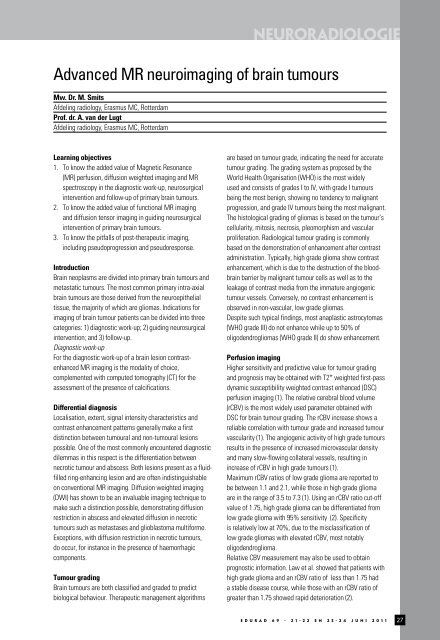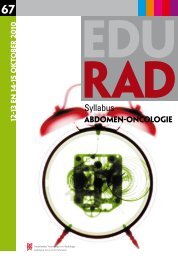HIER - Congress Company
HIER - Congress Company
HIER - Congress Company
Create successful ePaper yourself
Turn your PDF publications into a flip-book with our unique Google optimized e-Paper software.
Advanced MR neuroimaging of brain tumours<br />
Mw. Dr. M. Smits<br />
Afdeling radiology, Erasmus MC, Rotterdam<br />
Prof. dr. A. van der Lugt<br />
Afdeling radiology, Erasmus MC, Rotterdam<br />
Learning objectives<br />
1. To know the added value of Magnetic Resonance<br />
(MR) perfusion, diffusion weighted imaging and MR<br />
spectroscopy in the diagnostic work-up, neurosurgical<br />
intervention and follow-up of primary brain tumours.<br />
2. To know the added value of functional MR imaging<br />
and diffusion tensor imaging in guiding neurosurgical<br />
intervention of primary brain tumours.<br />
3. To know the pitfalls of post-therapeutic imaging,<br />
including pseudoprogression and pseudoresponse.<br />
Introduction<br />
Brain neoplasms are divided into primary brain tumours and<br />
metastatic tumours. The most common primary intra-axial<br />
brain tumours are those derived from the neuroepithelial<br />
tissue, the majority of which are gliomas. Indications for<br />
imaging of brain tumour patients can be divided into three<br />
categories: 1) diagnostic work-up; 2) guiding neurosurgical<br />
intervention; and 3) follow-up.<br />
Diagnostic work-up<br />
For the diagnostic work-up of a brain lesion contrastenhanced<br />
MR imaging is the modality of choice,<br />
complemented with computed tomography (CT) for the<br />
assessment of the presence of calcifications.<br />
Differential diagnosis<br />
Localisation, extent, signal intensity characteristics and<br />
contrast enhancement patterns generally make a first<br />
distinction between tumoural and non-tumoural lesions<br />
possible. One of the most commonly encountered diagnostic<br />
dilemmas in this respect is the differentiation between<br />
necrotic tumour and abscess. Both lesions present as a fluidfilled<br />
ring-enhancing lesion and are often indistinguishable<br />
on conventional MR imaging. Diffusion weighted imaging<br />
(DWI) has shown to be an invaluable imaging technique to<br />
make such a distinction possible, demonstrating diffusion<br />
restriction in abscess and elevated diffusion in necrotic<br />
tumours such as metastases and glioblastoma multiforme.<br />
Exceptions, with diffusion restriction in necrotic tumours,<br />
do occur, for instance in the presence of haemorrhagic<br />
components.<br />
Tumour grading<br />
Brain tumours are both classified and graded to predict<br />
biological behaviour. Therapeutic management algorithms<br />
neuroradiologie<br />
are based on tumour grade, indicating the need for accurate<br />
tumour grading. The grading system as proposed by the<br />
World Health Organisation (WHO) is the most widely<br />
used and consists of grades I to IV, with grade I tumours<br />
being the most benign, showing no tendency to malignant<br />
progression, and grade IV tumours being the most malignant.<br />
The histological grading of gliomas is based on the tumour’s<br />
cellularity, mitosis, necrosis, pleomorphism and vascular<br />
proliferation. Radiological tumour grading is commonly<br />
based on the demonstration of enhancement after contrast<br />
administration. Typically, high grade glioma show contrast<br />
enhancement, which is due to the destruction of the bloodbrain<br />
barrier by malignant tumour cells as well as to the<br />
leakage of contrast media from the immature angiogenic<br />
tumour vessels. Conversely, no contrast enhancement is<br />
observed in non-vascular, low grade gliomas.<br />
Despite such typical findings, most anaplastic astrocytomas<br />
(WHO grade III) do not enhance while up to 50% of<br />
oligodendrogliomas (WHO grade II) do show enhancement.<br />
Perfusion imaging<br />
Higher sensitivity and predictive value for tumour grading<br />
and prognosis may be obtained with T2* weighted first-pass<br />
dynamic susceptibility weighted contrast enhanced (DSC)<br />
perfusion imaging (1). The relative cerebral blood volume<br />
(rCBV) is the most widely used parameter obtained with<br />
DSC for brain tumour grading. The rCBV increase shows a<br />
reliable correlation with tumour grade and increased tumour<br />
vascularity (1). The angiogenic activity of high grade tumours<br />
results in the presence of increased microvascular density<br />
and many slow-flowing collateral vessels, resulting in<br />
increase of rCBV in high grade tumours (1).<br />
Maximum rCBV ratios of low grade glioma are reported to<br />
be between 1.1 and 2.1, while those in high grade glioma<br />
are in the range of 3.5 to 7.3 (1). Using an rCBV ratio cut-off<br />
value of 1.75, high grade glioma can be differentiated from<br />
low grade glioma with 95% sensitivity (2). Specificity<br />
is relatively low at 70%, due to the misclassification of<br />
low grade gliomas with elevated rCBV, most notably<br />
oligodendroglioma.<br />
Relative CBV measurement may also be used to obtain<br />
prognostic information. Law et al. showed that patients with<br />
high grade glioma and an rCBV ratio of less than 1.75 had<br />
a stable disease course, while those with an rCBV ratio of<br />
greater than 1.75 showed rapid deterioration (2).<br />
e d u r a d 6 9 - 2 1 - 2 2 e n 2 3 - 2 4 j u n I 2 0 1 1<br />
27



